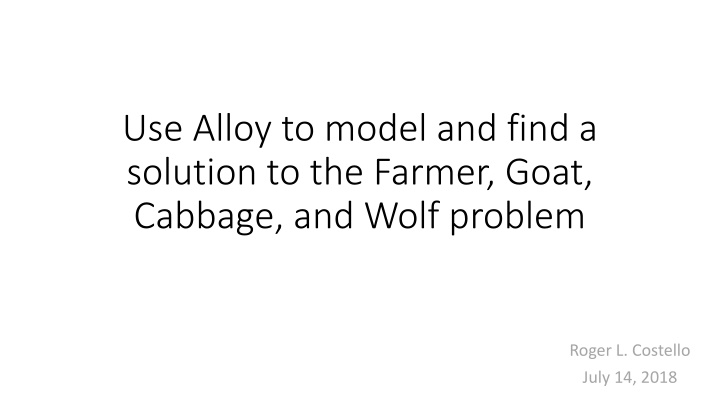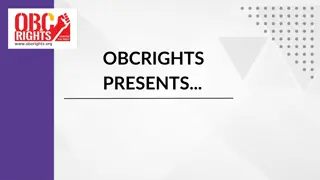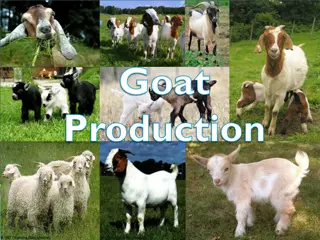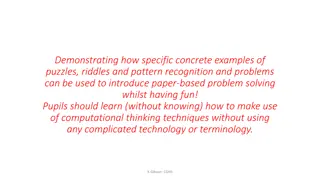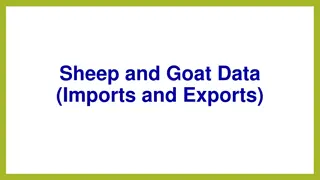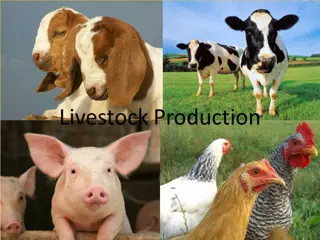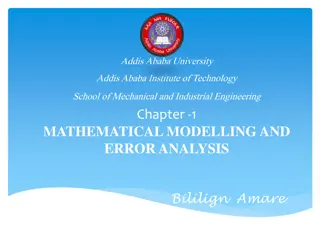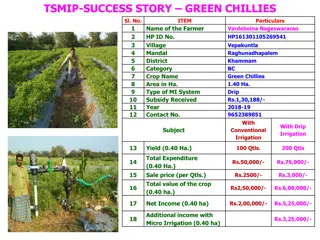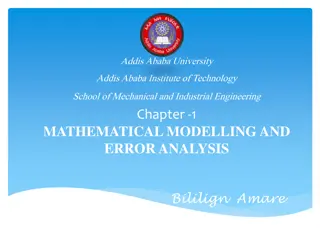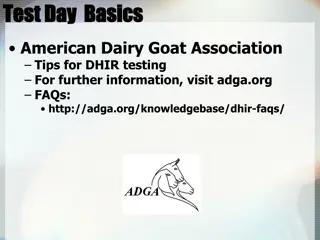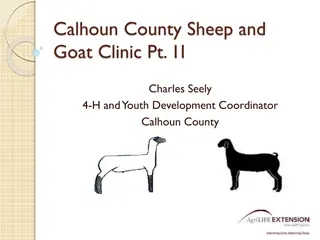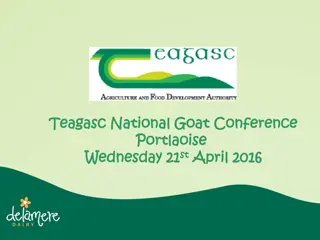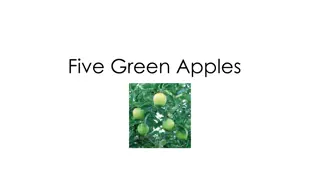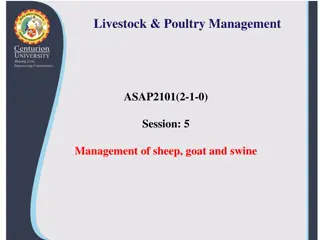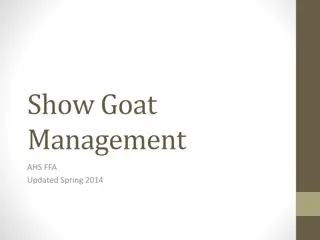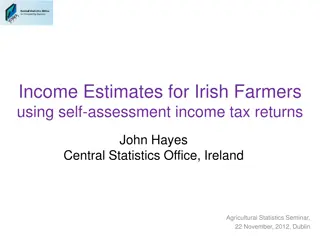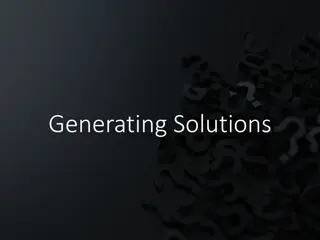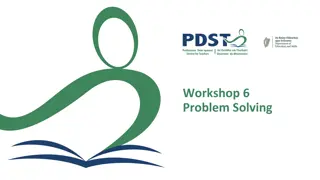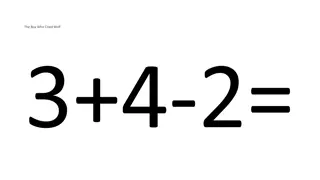Modeling and Solving the Farmer, Goat, Cabbage, and Wolf Problem
How Alloy can be utilized to model and find solutions to complex problems, such as the Farmer, Goat, Cabbage, and Wolf dilemma. Follow along as constraints are defined, the system is structured, and two solutions are presented in an efficient and systematic manner.
Download Presentation

Please find below an Image/Link to download the presentation.
The content on the website is provided AS IS for your information and personal use only. It may not be sold, licensed, or shared on other websites without obtaining consent from the author.If you encounter any issues during the download, it is possible that the publisher has removed the file from their server.
You are allowed to download the files provided on this website for personal or commercial use, subject to the condition that they are used lawfully. All files are the property of their respective owners.
The content on the website is provided AS IS for your information and personal use only. It may not be sold, licensed, or shared on other websites without obtaining consent from the author.
E N D
Presentation Transcript
Use Alloy to model and find a solution to the Farmer, Goat, Cabbage, and Wolf problem Roger L. Costello July 14, 2018
Use Alloy to model a system These slides show an example of using Alloy to model a system. It is an excellent illustration of the power of Alloy: merely express the components, the constraints on the components, and Alloy will find a solution.
Problem statement A farmer wants to ferry across a river a goat, cabbage, and wolf. But his boat only has room for him to take one at a time. If he leaves the goat with the cabbage, the goat will eat it. If he leaves the goat with the wolf, the goat will be eaten. How does the farmer get them from side 1 to side 2? side1 side2 RIVER farmer goat wolf cabbage
Heres how we will proceed We will solve the problem by modeling the system in Alloy and using the Alloy Analyzer to find a solution.
List the constraints Constraint: Farmer can ferry only one item at a time. Constraint: Cannot leave the goat and cabbage alone together. Constraint: Cannot leave the goat and wolf alone together.
Solution (cont.) side1 side2 side1 side2 RIVER RIVER farmer goat farmer goat cabbage wolf cabbage wolf side1 side2 side1 side2 RIVER RIVER farmer goat farmer goat cabbage wolf cabbage wolf
Model the system Each time the farmer crosses the river, record the items on each side. So, the model contains a series of snapshots of the River. Each snapshot records the items on side1 and side2 after a ferry trip. Here is a graphical depiction of one snapshot:
Heres how to express the set of snapshots: sig River { side1: set Item, side2: set Item } sig is a reserved word. It stands for signature. A signature declaration defines a set. In this case the signature defines a set of River snapshots.
River initially River after one ferry trip River after three ferry trips River after two ferry trips
Set of snapshots (cont.) sig River { side1: set Item, side2: set Item } sig is a reserved word. It stands for signature. A signature declaration defines a set. In this case the signature defines a set of River snapshots. You can think of a River snapshot as an object (in the object-oriented sense). The object has two fields called side1 and side2. side1 holds the items on the starting side of the river. side2 holds the items on the destination side of the River.
first River snapshot/object side1 side2 RIVER farmer goat wolf cabbage 4 items on side1 0 items on side2
Order the River objects Order the River objects to reflect the fact that there is a first ferry trip, then a second, and so forth. Call the ordering module with the set of River objects: open util/ordering[River] When you do that, the ordering module automatically generates a bunch of functions: first is the first River object. first.side1 is side1 of the first River object. prev is the previous River object. Suppose r is one of the River objects, then r.prev is the previous River object and s.prev.side1 is side1 of the previous River object. last is the last River object. next is the next River object.
Classification hierarchy I will use the term Item to denote any of farmer, goat, cabbage, or wolf. Define a simple classification hierarchy of the items: Item farmer goat cabbage wolf
Heres how to express the hierarchy in Alloy: abstractsig Item {} onesig farmer extends Item {} onesig goat extends Item {} onesig cabbage extends Item {} onesig wolf extends Item {} The signature declaration for Item is abstract, which means its members come from its extension signatures. farmer, goat, cabbage, and wolf are extension signatures of Item. The set named farmer has just one member and it is a subtype of Item. Ditto for goat, cabbage, and wolf.
Equivalent abstractsig Item {} onesig farmer extends Item {} onesig goat extends Item {} onesig cabbage extends Item {} onesig wolf extends Item {} enum Item { farmer, goat, cabbage, wolf } We will typically use this form since it is more succinct.
The initial River object Constraint: The initial River object that is, the initial state of the system must have the farmer, goat, cabbage, and wolf on side1 and nothing on side2. Constraints are expressed in facts. Stated another way, constraints are packaged in facts. -- Initially the farmer, goat, cabbage, and wolf -- are on side1 and nothing is on side2 fact { first.side1 = farmer + goat + cabbage + wolf first.side2 = none }
+ means union fact { first.side1 = farmer + goat + cabbage + wolf first.side2 = none } The plus symbol ( + ) does not mean addition, it means set union. none is a keyword meaning the empty set. All constraints within curly braces are implicitly and ed together.
Sets are the foundation of Alloy Alloy Sets
A River object must have all items on side2 Constraint: In some River object, the farmer, goat, cabbage, and wolf must be on side2 and nothing on side1. That constraint is expressed in another fact: -- At some point the farmer, goat, cabbage and wolf -- are all on side2 of the river fact { some r: River | (r.side2 = farmer + goat + cabbage + wolf) and (r.side1 = none) }
Cont. fact { some r: River | (r.side2 = farmer + goat + cabbage + wolf) and (r.side1 = none) } The keyword some means: at least one (i.e., one or more) The vertical bar ( | ) is read is such that Read the constraint as: There is a River r in which r.side2 has farmer, goat, cabbage, and wolf, and r.side1 has nothing
Equivalent fact { some r: River | (r.side2 = farmer + goat + cabbage + wolf) and (r.side1 = none) } fact { some r: River { r.side2 = farmer + goat + cabbage + wolf r.side1 = none } }
Every River object has these constraints Constraint: If the farmer is on side1, then the goat and cabbage must not be on side2, and vice versa. Constraint: If the farmer is on side1, then the goat and wolf must not be on side2, and vice versa.
The constraints are expressed in a fact: -- At no point are the goat and cabbage alone together -- and at no point are the goat and wolf alone together. fact { no r: River | (farmer in r.side1) and (goat + cabbage in r.side2) or (farmer in r.side2) and (goat + cabbage in r.side1) or (farmer in r.side1) and (goat + wolf in r.side2) or (farmer in r.side2) and (goat + wolf in r.side1) }
fact { no r: River | (farmer in r.side1) and (goat + cabbage in r.side2) or (farmer in r.side2) and (goat + cabbage in r.side1) or (farmer in r.side1) and (goat + wolf in r.side2) or (farmer in r.side2) and (goat + wolf in r.side1) } The keyword no means: Zero occurrences. The keyword in means: Is in the set, e.g., A in B means all the members of set A are in set B. Read the constraint as: There is no River object r in which the farmer is on r.side1 while the goat and cabbage are on r.side2, or the farmer is on r.side2 while the goat and cabbage are on r.side1, or the farmer is on r.side1 while the goat and wolf are on r.side2, or the farmer is on r.side2 while the goat and wolf are on r.side1.
Case 1: Farmer moves an item to side 2 Constraint: For each River object r, if the farmer is on r.side2 (previously he was on r.side1), then r.side2 contains one new item (plus the farmer) and r.side1 contains one less item (and minus the farmer).
Constraint: For each River object r, if the farmer is on r.side2 (previously he was on r.side1), then r.side2 contains one new item (plus the farmer) and r.side1 contains one less item (and minus the farmer). -- Consider some River object. If the farmer is on side1 in -- the previous River object, then in the current River object -- he is on side2 along with some item (goat, cabbage, or wolf) -- that is on side1 in the previous River object. fact { all r: River | farmer in r.prev.side1 => some i: r.prev.side1 - farmer | (r.side1 = r.prev.side1 - farmer - i) and (r.side2 = r.prev.side2 + farmer + i) }
Implication (if-then) fact { all r: River | farmer in r.prev.side1 => some i: r.prev.side1 - farmer | (r.side1 = r.prev.side1 - farmer - i) and (r.side2 = r.prev.side2 + farmer + i) } The arrow (equals symbol followed by greater-than symbol) means implies . A => B means this: If constraint A is satisfied, then constraint B must be satisfied.
Set subtraction fact { all r: River | farmer in r.prev.side1 => some i: r.prev.side1 - farmer | (r.side1 = r.prev.side1 - farmer - i) and (r.side2 = r.prev.side2 + farmer + i) } The minus symbol ( - ) means set difference (set subtraction).
Case 2: Farmer might move an item to side 1 Constraint: If the farmer is on side1 (previously he was on side2), then side1 might contain one new item (plus the farmer) and side2 might contains one less item (minus the farmer). Why do I say might ? Answer: When the farmer returns to side1 he may or may not bring back an item.
Constraint: If the farmer is on side1 (previously he was on side2), then side1 might contain one new item (plus the farmer) and side2 might contains one less item (minus the farmer). Why do I say might ? Answer: When the farmer returns to side1 he may or may not bring back an item. -- Consider some River object. If the farmer is on side2 in the previous River object, then -- there are two cases: -- (1) All the items (farmer, goat, cabbage, and wolf) are on side2 in the previous River -- object. In the current River object all the items remain on side2. -- (2) Not all the items are on side2 in the previous River object. In the current River -- object the farmer is on side1 and there may or may not be some item (goat, -- cabbage, or wolf) on side1 that is on side2 in the previous River object. fact { all r: River | farmer in r.prev.side2 => r.prev.side2 != farmer + goat + cabbage + wolf => some i: r.prev.side2 - farmer | ((r.side2 = r.prev.side2 - farmer - i) and (r.side1 = r.prev.side1 + farmer + i)) or ((r.side2 = r.prev.side2 - farmer) and (r.side1 = r.prev.side1 + farmer)) }
Constraint: Constraint: Once all items are moved to side 2, the River objects do not change -- Consider some River object. If all the items (farmer, -- goat, cabbage, and wolf) are on side2 in the previous River -- object, then in the current River object all items remain on -- side2 and there are none on side1. fact { all r: River - first | r.prev.side2 = farmer + goat + cabbage + wolf => (r.side2 = farmer + goat + cabbage + wolf) and (r.side1 = none) }
Use the run command to generate instances By default, Alloy limits the number of members of each set to 3, which means the default is 3 River objects. The farmer cannot get all items to side2 in just 3 ferry trips. I bumped up the default to 4 and ran Alloy. No instance found. I bumped it up to 5. No instance found. No instance was found until I bumped it up to 8: run {} for 8
run {} for 8 When you call the run command you must provide a set of additional, run-specific constraints that you want applied to the model. For this model we have already specified all the constraints we desire. The open/close curly brace is a constraint that always returns true. So, this run command says: Hey Alloy Analyzer, find all the instances that satisfy the constraints defined in the model, no additional constraints are specified on this run, allow for up to 8 members in the sets.
Upon issuing the run command the Alloy Analyzer converts the model (structural components plus constraints) into a huge binary expression, passes the expression to the SAT tool which determines values for the variables in the expression. The Alloy Analyzer converts the SAT results into the form used by the model and displays the results.
open util/ordering[River] sig River { side1: set Item, side2: set Item } enum Item { farmer, goat, cabbage, wolf } fact { first.side1 = farmer + goat + cabbage + wolf first.side2 = none } fact { some r: River | (r.side2 = farmer + goat + cabbage + wolf) and (r.side1 = none) } fact { no r: River | (farmer in r.side1) and (goat + cabbage in r.side2) or (farmer in r.side2) and (goat + cabbage in r.side1) or (farmer in r.side1) and (goat + wolf in r.side2) or (farmer in r.side2) and (goat + wolf in r.side1) } fact { all r: River | farmer in r.prev.side1 => some i: r.prev.side1 - farmer | (r.side1 = r.prev.side1 - farmer - i) and (r.side2 = r.prev.side2 + farmer + i) } fact { all r: River | farmer in r.prev.side2 => r.prev.side2 != farmer + goat + cabbage + wolf => some i: r.prev.side2 - farmer | ((r.side2 = r.prev.side2 - farmer - i) and (r.side1 = r.prev.side1 + farmer + i)) or ((r.side2 = r.prev.side2 - farmer) and (r.side1 = r.prev.side1 + farmer)) } fact { all r: River - first | r.prev.side2 = farmer + goat + cabbage + wolf => (r.side2 = farmer + goat + cabbage + wolf) and (r.side1 = none) } run {} for 8
Earlier I said this: sig River { side1: set Item, side2: set Item } sig is a reserved word. It stands for signature. A signature declaration defines a set. In this case the signature defines a set of River snapshots. You can think of a River snapshot as an object (in the object-oriented sense). The object has two fields called side1 and side2. side1 holds the items on the starting side of the river. side2 holds the items on the destination side of the River. As a first step, it s okay to think of each River as an object with two fields. But that s actually not correct. Let s see what is actually correct.
Everything is a set sig River { side1: set Item, side2: set Item } River: { River0, River1, River2, River3, River4, River5, River6, River7 }
sig River { side1: set Item, side2: set Item } River: { River0, River1, River2, River3, River4, River5, River6, River7 } Question: Why 8 members in the River set? Answer: Because the run command specified 8 members: run {} for 8
sig River { side1: set Item, side2: set Item } River: { River0, River1, River2, River3, River4, River5, River6, River7 } side1: { (River0, farmer), (River0, cabbage), (River0, goat), (River0, wolf), (River1, cabbage), (River1, wolf), (River2, farmer), (River2, cabbage), (River2, wolf) } side2: { (River1, farmer), (River1, goat), (River2, goat), (River3, farmer), (River3, goat), (River3, wolf), , (River7, farmer), (River7, cabbage), (River7, goat), (River7, wolf) }
Alternate depiction of the sets River side1 side2 River0 River0 farmer River1 farmer River1 River0 cabbage River1 goat River2 River0 goat River2 goat River3 River0 wolf River3 farmer River4 River1 cabbage River3 goat River5 River1 wolf River3 wolf River6 River2 farmer River7 River2 cabbage River2 wolf
Result of making River ordered open util/ordering[River] first next prev River0 River0 River1 River1 River0 River1 River2 River2 River1 last River2 River3 River3 River2 River7 River3 River4 River4 River3 River4 River5 River5 River4 These sets are automatically created River5 River6 River6 River5 River6 River7 River7 River6
Join two sets (. is the join operator) prev s s.prev River2 River1 River0 River2 River1 River3 River2 River4 River3 River5 River4 River6 River5 River7 River6
prev s s.prev River2 River1 River0 River1 River2 River1 River3 River2 River4 River3 River5 River4 River6 River5 River7 River6
Two join operations prev side1 s.prev.side1 s River2 River1 River0 River0 farmer River2 River1 River0 cabbage River3 River2 River0 goat River4 River3 River0 wolf River5 River4 River1 cabbage River6 River5 River1 wolf River7 River6 River2 farmer River2 cabbage River2 wolf
prev side1 s.prev.side1 s River2 River1 River0 River0 farmer cabbage River2 River1 River0 cabbage wolf River3 River2 River0 goat River4 River3 River0 wolf River5 River4 River1 cabbage River6 River5 River1 wolf River7 River6 River2 farmer River2 cabbage River2 wolf
When to model? Model things that are particularly intricate. Most people underestimate the intricacy of problems, so modeling should be applied more broadly. [Daniel Jackson]
Alloy is a declarative language An imperative language specifies the actions to take: do this, then do that, then do Programming languages such as Java are imperative languages A declarative language specifies what you want, but not how to do it, i.e., what you want, but not what actions to take. Alloy is a declarative language
Alloy is declarative (cont.) In the description of the farmer, goat, cabbage, wolf problem I talked about the farmer ferrying items across the river. But in the model there is no mention of ferrying or any kind of movement. Why? Because ferry and move are actions. In declarative descriptions there are no actions.
Highly declarative description of the farmer, goat, cabbage, wolf problem Let me tell you about a farmer, goat, cabbage, and wolf at a river. At time t=0 the farmer, goat, cabbage, and wolf are on side1 of the river. If the farmer is on side1 at time t, then at time t+1 the farmer is on side2; additionally, one other item on side1 at time t is on side2 at time t+1. If the farmer is on side2 at time t and all the other items are also on side2, then at time t+1 they are still on side2; but if the farmer is on side2 at time t, and not all the other items are on side2, then at time t+1 the farmer is on side1 and possibly one of the other items is on side1. If the farmer is on side2, then the goat and cabbage are not on side1, and vice versa. If the farmer is on side2, then the goat and wolf are not on side1, and vice versa. Do Lab1
